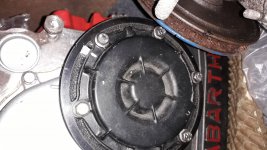Al,
NO KIDDING (re: trusting a shop's work). Hard lesson learned indeed. At least I learned how "not to" by doing - I can;t learn a thing unless I actually do it.
The 19mm nut - no, I didn't remove or inspect, though I suppose I should have.
Regarding the choke flap, keep in mind that I didn't engage the choke when I started the car in the video. Adjustment is gently bending of the linkage, yes?
Now that the little bugger is running, I might as well fill up the forum with other requests and such

Hi Grubeguy,
Sometimes mistakes are made in 'shops e.g. one person might have cleaned the outside of the carb, intending to strip it later. Another person might have seen the 'cleaned' carb, assumed it was finished and sent it back to the customer? The amount of corrosion/green build-up on the float is unusual - I wonder if some sort of chemical soak was used on this carb and not cleaned off?
The mesh filter under the 19mm nut beside the fuel pipes on the carb is accessible without removing the carb top (you're probably fed-up doing this).
Just put a rag underneath as a small amount of fuel will escape when the nut is undone. The mesh filter usually stays in the hole and just pulls out - a small mirror is your friend here in seeing what you're doing. Just clean and refit the filter followed by the 19mm nut -iirc this nut doesn't use any type of sealing washer, it has a taper seat instead.
As you're running the engine with an idle speed of 1500 rpm at the moment, there's no point in messing with the choke linkage connecting rod to the throttle unless you later cut the idle speed down to c.900rpm and want to be able to start the engine in cold conditions. (I note that this doesn't apply to where you are at present, although I did hear mention of the choke and did iirc see it being engaged early on in your video when you were trying but failing to get the engine to start).
You might compare this link rod on your other carbs to get an idea of the 'normal shape' - it looks to be to have been straightened a little, there's usually a gentle but noticeable slight bend in one location, maybe 1/3 of the way along? (relying on 40 year old memories here

).
As you're running with an idle speed of 1500? rpm at present, bear in mind that the engine is probably drawing fuel from the progression holes in the carb bore and maybe not from the idle fuel hole. As a result you might find that adjusting the idle mixture screw has little or no effect, I'd recommend setting this mixture adjustment screw to 1, 1/2 turns out from a lightly seated position and leave it alone. (just for clarity - the idle
mixture screw is the one that screws into the carb body near it's base, the idle
speed screw is the one that is fitted on the throttle linkage and it's end bears against the carb body).
Hth,
Al.


